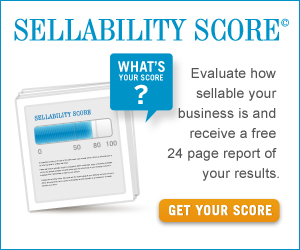Republished with permission from Built to Sell Inc.
In any negotiation, being the person who makes the first move usually puts you at a slight disadvantage. The first-mover tips their hand and reveals just how much he/she wants the asset being negotiated.
Likewise, when considering the sale of your business, it is always nice to be courted, rather than being the one doing the courting. The good news is, the chances of getting an unsolicited offer from someone wanting to buy your business are actually increasing.
According to the Q2, 2014 Sellability Tracker analysis released in July 2014, 16% of business owners have received an offer in the last year, which is up 37% over Q1. Said another way, you’re 37% more likely to get an offer to buy your business today than you were at the beginning of the year.
Big companies are buying little ones for a lot of reasons and the current market conditions are accelerating their appetite: interest rates are low and stock markets are high, which provide the ideal platform for acquirers to realize a return on their investment from buying a business like yours.
So how do you ensure you are on their shopping list? Here are five ways to get noticed by an acquirer:
1. Win an award
Getting recognized as the “Widget Maker of the Year” by the Widget Makers Association is a great way to get the attention of acquirers in your industry.
2. Hire a PR person
Engaging a public relations professional to tell your story to the media can get you on the radar of buyers in your industry. A lot of media relations professionals focus on the big mainstream publications, and while these are important, ensure that your PR firm also targets trade publication and industry-specific websites that are read by acquirers in your industry.
3. Host an event
Consider hosting an event (e.g., conference, tradeshow, summit) for your industry and invite representatives from potential acquirers to attend. Being invited to an industry event can be flattering for acquirers and it is a good way to get them to notice you as an industry leader.
4. Join a board
If an executive from a company you think would make a natural buyer for your business is serving on a board of directors, consider joining the board. Serving on a board together can be a great way for an acquirer to notice you and your company without you having to say you’re for sale.
5. Grab lunch
Consider inviting a senior executive from a potential acquirer to share a meal under the guise of discussing trends in your industry. At the very least, you may glean some useful information about how big companies are seeing your industry evolve. At best, your lunch mate may realize that your company could play a key role in helping them grow.
The sale of your business is a delicate dance where it is usually better to be the courted, rather than the courter. Acquirers are on the hunt for new businesses, and having them notice you will put you in a position of strength when you get to sit down at the negotiation table.
Why not find out now if your business is sellable?
This free online tool is the only no-risk step you can take to determine if your business is ready to get full value. Fast-track your analysis by taking advantage of this free, no-obligation free online tool.
This Sellability Score you instantly receive is a critical component to any business owner’s complete financial plan and is something that, until now, we have only made available to existing clients.
However, we recognized that there is value in knowing in advance of working with a financial planner whether or not your largest asset is ready to be exchanged for your retirement nest egg. Our view is that you are better to learn more about your businesses sellability today and find out how your business scores on the eight key attributes so that you can ensure you obtain full value.
If your business part of your retirement plan, finding out your sellability score will be the best 10 min. you could ever spend working “on” your business.
 For more free information on Creating A Business Owner’s Dream Financial Plan, you can listen to a free, eight part series we did exclusively for business owners. The show is also available to subscribe to for free via iTunes.
For more free information on Creating A Business Owner’s Dream Financial Plan, you can listen to a free, eight part series we did exclusively for business owners. The show is also available to subscribe to for free via iTunes.













